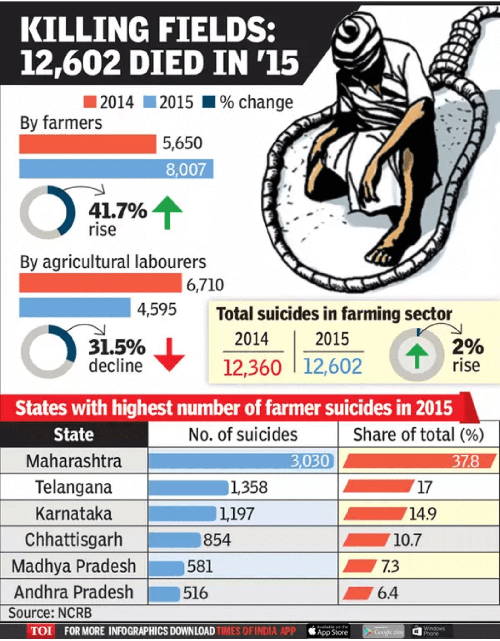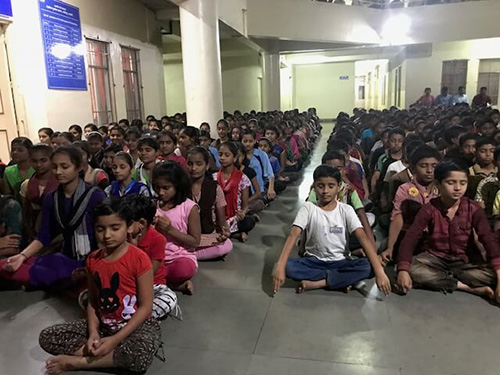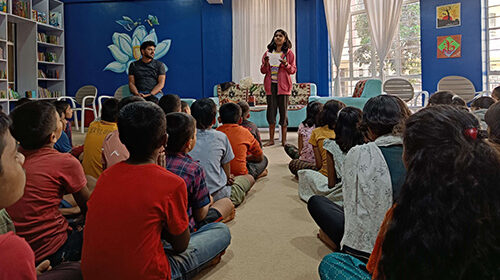In 2015, Maharashtra witnessed a devastating surge in farmer suicides, driven primarily by
consecutive years of drought that led to widespread crop failures. Reports from the National
Crime Records Bureau (NCRB) identified bankruptcy and indebtedness as the leading causes,
with most loans taken from formal financial institutions such as banks and registered
microfinance organizations.
A deeper examination of this crisis reveals a troubling shift in agricultural practices. Many
affected farmers had transitioned to cultivating cash crops, which come with significantly higher
production costs—particularly for seeds. In prolonged drought conditions, this shift not only
proved financially burdensome but also highly unsustainable. Previously, these regions relied on
indigenous crops better suited to local environmental conditions. However, as agricultural
economist Dr. Deb explains, India’s evolving food systems—driven by changing import and
export practices—have compelled farmers to adapt, often at great personal and financial risk.

While economic devastation is well-documented, the emotional toll on the families left
behind—especially the children—remains less discussed. The cycle of loss extends beyond
financial ruin, shaping the lives of those who survive. In her article Confronting Farmer Suicides
in India, Akta Kaushal examines how this crisis has been woven into public discourse, drawing a
parallel to the 2010 satirical film Peepli Live. The film, while humorous on the surface, exposes
the grim reality of rural distress and media sensationalism. But should we really be laughing?
The normalization of such a devastating issue forces us to ask: at what point will those removed
from its immediate impact recognize it as an urgent crisis rather than a distant, abstract problem?
The consequences of farmer suicides extend far beyond economic hardship. Dr. Sangeeta Lagad,
a psychologist working with disaster-affected children, has witnessed firsthand how this crisis
deeply impacts young survivors. Many widows are unjustly blamed for their husbands’ deaths,
exacerbating the trauma their children endure. Suicide doesn’t end with the individual; it ripples
through families, communities, and generations.
Dr. Lagad recounted heartbreaking cases of children who had not only witnessed their parents’
suffering but had also attempted suicide themselves. Some succeeded. Their stories serve as a
stark reminder: when children experience such unimaginable loss, it becomes our moral
responsibility to understand their needs, provide support, and work toward a world where they
are given the opportunity to heal and thrive.

Farmers’ children rehabilitated
“It was difficult for the children, since they were away from their family and rehabilitated in an
institute,” Dr. Lagad shared. “And when their family members did come to visit, they would talk
about their issues faced because of the death. They had no one here, everything was new to them—from rural to an urban setting, the food, every aspect—they had to adjust to this new
place while they were grieving.”
Empowerment begins with recognizing that the impact of suicide is not limited to the
individual—it leaves lasting emotional and social scars. Addressing this crisis requires more than
just acknowledging statistics; it calls for a shift in perspective. Understanding the needs of these
families must go beyond intellectual comprehension—it must be rooted in compassion and a
commitment to dismantling the structures that perpetuate poverty and despair.
In 2018, our founder, Seena Jacob, stepped into a shelter home that housed 500 children of
farmers. As she stood before them in a large hallway, all 500 boys and girls sat on the floor,
looking up at her with wide, expectant eyes. At that moment, she felt a wave of weight settle
over her. Every single one of those children had lost a parent to suicide, trapped in the
unrelenting cycle of drought, debt, and despair.
She promised them she would come back. She promised them a space where they could escape,
dream, and heal—a library filled with stories that could give them hope. And thanks to the
generosity of Bookwallah’s donors, Bookwallah did just that. In 2019, Bookwallah built a library
in their shelter home and together we named it – The Lotus Library, a symbol of growth in
adversities, bringing books and storytelling sessions designed to help them rebuild their sense of
self and possibility.

Storytelling sessions at The Library of Lotus
At Bookwallah, we continue to support these children through the power of stories and imagination. But this mission is not ours alone—every act of awareness, empathy, and generosity
counts. How can you help? By spreading awareness, supporting initiatives like ours, or simply
acknowledging the reality behind these statistics, you become part of the solution. Because
sometimes, resilience begins with the ability to imagine something better.
